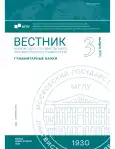An Experimental Study of the Psychological Relevance of the Symbolic Content of Color Meanings (based on the material of the Chinese Language)
- Autores: Pishchalnikova V.A.1, Jiaqian W.1
-
Afiliações:
- Moscow State Linguistic University
- Edição: Nº 3(897) (2025)
- Páginas: 33-39
- Seção: Linguistics
- URL: https://journal-vniispk.ru/2542-2197/article/view/286469
- ID: 286469
Citar
Texto integral
Resumo
The purpose of the study is to establish the psychological relevance of the symbolic content of color meanings; the main method is a free associative experiment; the presentation material is specific field structures of reactions. The paper proposes an experimental technique for diagnosing the psychological relevance of the symbolic content of color lexemes; it is established that the frequency of symbolic reactions significantly depends on the substantial complexity of traditional symbolic meanings and their significance in modern culture, allowing the development of new meaningful components. Nuclear reactions show a high level of embedding of color names as representatives of symbolic meanings in associative-verbal networks.
Sobre autores
Vera Pishchalnikova
Moscow State Linguistic University
Autor responsável pela correspondência
Email: pishchalnikova@mail.ru
Doctor of Philology (Dr. habil.), Professor, Professor at the Department of General and Comparative Linguistics, Head of the Laboratory of Psycholinguistics
RússiaWu Jiaqian
Moscow State Linguistic University
Email: 353737681@qq.co
Postgraduate Student of the Department of General and Comparative Linguistics
RússiaBibliografia
- Pischalnikova, V. A. (2020). Basic values: methodological problems of psycholinguistic research. Vestnik of Moscow State Linguistic University. Humanities, 3(832), 20–35. (In Russ.)
- Qu Yun (2022). Representation of the main values of modern China in a polycoded advertising text. Vestnik of Moscow State Linguistic University. Humanities, 2(857), 170–175. (In Russ.)
- Yao Zhipeng (2018). Comparative characterization of associative fields responsive / 富有同情心的 according to the data of free associative experiment. Vestnik of Moscow State Linguistic University, 9(801), 223–234. (In Russ.)
- Bai Caixia (2018). Structural and content features of the concept “corruption” in Chinese linguoculture. Izvestiya South-West State University. Series of linguistics and pedagogy, 1(26), 42–47. (In Russ.)
- Qu Yun, Pishchalnikova, V. A. (2024). Reflection of cultural values in Chinese commercial advertising. Ethnopsycholinguistics, 1(16), 7–19. (In Russ.)
- Chen Xifan (2024). Dynamics of value content and its representation in phraseological units. Ethnopsycholinguistics, 2(17), 103–116. (In Russ.)
- Pischalnikova, V. A., Dubkova, O. V., Tsun Fengling, Yao Zhipeng (2020). The world picture of the Chinese: theory and practice of scientific research. Moscow: R-Valent (In Russ.)
- Pischalnikova, V. A., Stepykin, N. I. (2023). Speech action as a means of realising the psychological meaning of a word (on the material of the associative field of the lexeme citizen). Vestnik of Moscow State Linguistic University. Humanities, 9(877), 41–49. (In Russ.)
- 程士元. 中国文化中的红色情结. 艺术探索 (2006), 03, 118+123+144. = Cheng Shiyuan (2006). The love of red in Chinese Culture. Art Studies, 03, 118+123+144. (In Chinese)
- 张地. 红色在中国文化中的内隐表征. 苏州大学 (2023) = Zhang Di. (2023). Implicit representation of red color in Chinese culture: PhD thesis Suzhou. (In Chinese)
- 欧秋耘,李枫桥. 东方的桃子与西方的苹果——文化意象对比及翻译. 湖北第二师范学院学报, 2012, 29 (01):123-126 = Ou Qiuwei, Li Fengqiao (2012). A peach in the East and an apple in the West – a comparison and translation of cultural images. Vestnik of Hubei Teachers’ Training Institute, 2, 29(01), 123–126. (In Chinese)
Arquivos suplementares










